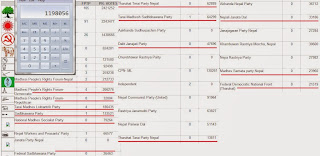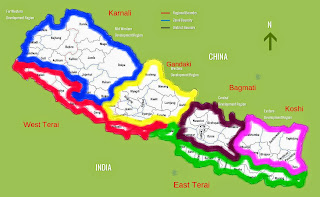|
|
| Regions and eligible countries for the Diversity Visa lottery (Photo credit: Wikipedia) |
With the newly organized elections for the first time the
Non Resident Nepali Association has become a mass based organization in America, but barely so. If there are 200,000
Nepalis in America, the 2,000 people who voted for Khagendra GC are but one per cent of the target population. And so the immediate focus has to shift to a massive membership drive, much of which can be done online. For elections to be held within a year, the voter base has to cross the 10,000 mark. Even with 20,000 members the organization will have but organized perhaps only 10% or less of the target population.
I think the membership drive by now has hit an autopilot mode. There is a natural rush among the people to join the organization. That is a far cry from the ground reality only a few years back. The use of digital tools has made a major contribution to that end.
But the membership drive is only part of the story. Modern digital tools make possible for an organization to become truly grassroots, not just during membership drives and elections, but also after. A candidate with a public
Facebook page that gets updated regularly allows for an election to go beyond name and face recognition to actually igniting discussions on issues. Photos and videos from events shared on such a public Facebook page draw people in, regardless of if they showed up or not, and most can’t.
A national organization necessarily has to hold its regular meetings over conference calls. International meetings can be held over Skype. There are still conferences people show up for, but digital meetings allow for broad participation.
But the most cutting edge thing the NRNA could do would not be digital at all. Encouraging ordinary members to organize monthly home meetings would go a long way to turning the organization truly grassroots. In person is still supreme, and will continue to be.
Those monthly home meetings could be about discussing agenda items sent from the central committee, but also about suggesting agenda items that the central committee should discuss. The communication has to be two way. But the primary thrust of such meetings has to be the upward mobility of members. Most Nepalis in
NYC make less than 10 dollars an hour. How can more and more members be guided to possibly making more than 10 dollars per hour? There has to be brainstorming, there has to be note sharing.
The local NRNA has to build formal vehicles to encourage more and more people in
Nepal to apply for the
diversity visa lottery, and make it smoother for lottery winners to transition their way into America, whether they personally know someone or not. But once here most Nepalis stay stuck in where they started for a decade or more. I think the monthly home meeting could help steer people to look beyond where they stand right now.
A lot of socioeconomic mobility is about exercising the muscles between your ears. There is so much to learn online for free or cheap that can help people move up the income brackets. And being organized helps. There is a clear social component to learning.
Shared wifi can cost as little as $10 per person. You can get a
Chromebook for $250. And that is all you need to go to university. We live in an era of lifelong education. No Nepali I know is too educated to learn some more.
So far NRNA membership drives feel like an exercise to help a few dozen people get their fix of politicking and for abstract far flung concepts like dual citizenship. NRNA membership has to be made of month to month immediate relevance to its ordinary members. Beyond taking the membership of the organization past 20,000, that push should be the real thrust of the association.
Keeping all book keeping transparent online, keeping all meeting minutes transparent online would go a long way to making the organization truly grassroots. Heck, in this day and age it should be possible to produce and share video minutes of meetings on Facebook. You get a minute here, a minute there, and edit and share.
If there are two million Nepalis outside
South Asia, and if 200,000 of them are in America, the country’s share comes to about 10%. Funny that the top country on the planet has been the last to get organized to some extent as far as the Non Resident Nepali movement is concerned. Perhaps some day NRNA
USA might even aspire for global leadership. Going decidedly grassroots and being number one in the use of digital technology is how you get there.








